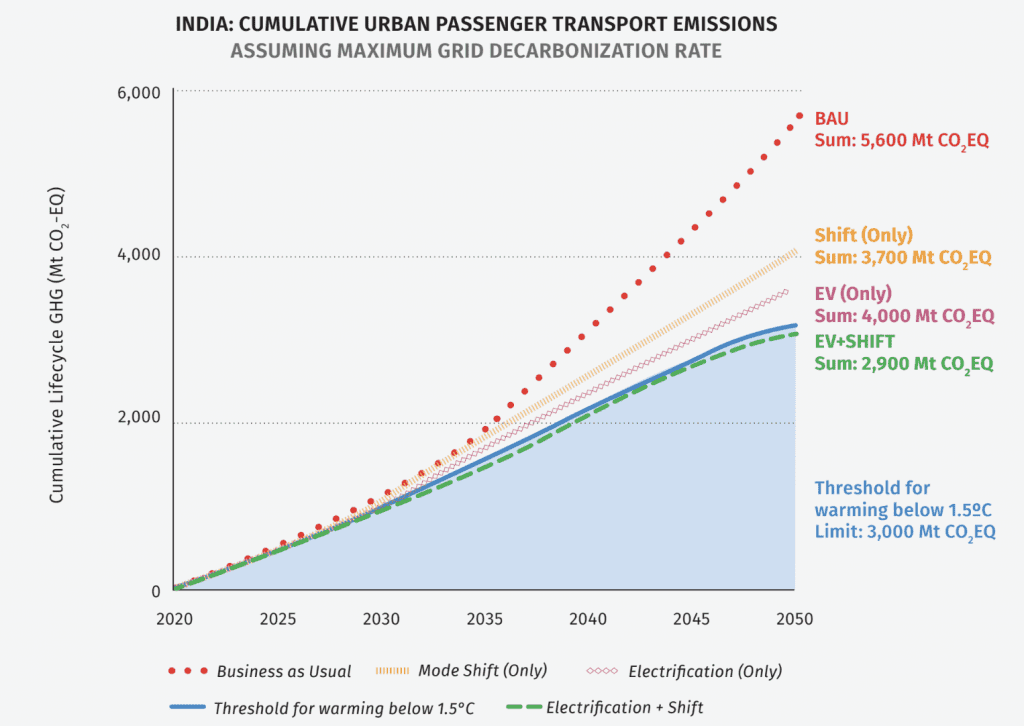Reducing greenhouse gas emissions from transport is crucial to meet India’s climate action commitments and limit future global warming to 1.5°C. This is especially urgent amidst recurring hazardous air quality crises in Delhi, Mumbai, and other major Indian cities. The road transport sector, one of the main sources of air pollution in nearly every Indian city, requires immediate attention and action.
A report by ITDP and the University of California, Davis—the Compact Cities Electrified: India roadmap—shows that the solution lies in developing compact and dense cities that can shift most trips to less polluting modes like walking, cycling, and public transport while simultaneously facilitating a rapid electrification of all vehicle modes. Adopting these combined strategies could potentially save the Indian government over INR 150 lakh crore in the next 30 years and result in lower travel costs, and a reduction in projected energy demand by almost one-third, not to mention more resilient, equitable, and sustainable cities.
The study outlines four possible scenarios for the next 30 years of urban passenger transport and resulting emissions in India:
- Business as Usual – A continuation along India’s current trajectory toward a car-oriented society powered by fossil fuels.
- Mode Shift (Only):– Cities embrace compact land-use policy and redesign transport systems to make walking, cycling, and public transport use as easy as car use.
- Electrification (Only):– Cities pursue EVs intensely and almost exclusively as the strategy for decarbonising.
- Electrification + Shift:– Combination of high electrification and high shift. Extensive electrification of public and private vehicles and a shift in city designs to prioritize non-motorized transportation.
The research shows that neither strategy on its own is capable of reducing emissions to a level compatible with limiting future global warming to 1.5°C. India will require both strategies—Electrification + Shift—to meet its Paris Agreement commitments and its goal of achieving net zero by 2070.

Why does India need compact electrified cities?
Recent air quality reports have identified India as the source of approximately 59% of the world’s increased pollution since 2013. Transport is the most rapidly growing source of emissions in the country, accounting for roughly a tenth of the overall emissions. Road transport makes up a whopping 90 percent of this, with the number of vehicles on the road increasing about four-fold since the early 2000s.
Despite this, Indian cities persist in prioritizing personal motor vehicles, consequently creating unsafe conditions for pedestrians and cyclists and inadequately meeting the demand for high-quality public transport. Addressing emissions and enhancing urban life quality in these cities is a critical need. With the United Nations projecting a near doubling of India’s urban population between 2020 and 2050, signifying nearly half of the urban areas in India will be newly built in the next 30 years. As this happens, it is especially important to avoid replicating the models of car-centric urban development.
Investing in creating compact electrified cities will not only ensure India meets its climate commitments, but result in massive economic savings and reduced travel costs for residents of Indian cities. Over the next 30 years, the Electrification + Shift approach could save more than $1 trillion over the next 30 years. This funding could be redirected to invest in critical sectors like public health and education. Additionally, combining EVs and compact cities would decrease projected energy demand by almost one-third, freeing up electricity for consumers or for other energy-intensive aspects of development.
In addition to savings and lowered energy demand, creating compact electrified cities would also facilitate economic inclusion, reduce air pollution, and minimize road fatalities.
India’s roadmap to CCE
The Compact Cities Electrified: India report provides a country-specific roadmap for India, estimating the quantities and costs of infrastructure needed for the transition and the potential impacts over the next 30 years. The report highlights seven critical goals which require strong action from governments at all levels—including ensuring every citizen gets a fair share of road space; improving walking, cycling, and public transport; and accelerating the adoption of green mobility.
While the scale of transformation required is massive, it is not unprecedented. Paris decreased car travel by almost 50 percent in 30 years by investing in other modes and traffic control strategies. Similarly, Jakarta, Tehran, and Bogotá have each built public transport systems catering to over a million riders a day in under 15 years. Indian cities have the potential to achieve this too.

